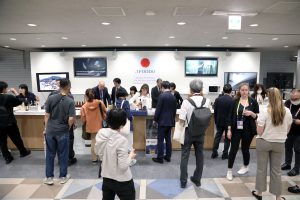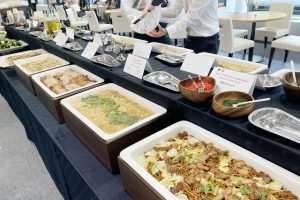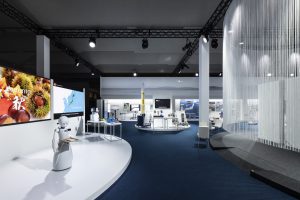At the IMC, Congrès was responsible for organisation of the dining services for the media including food presentation corners, the exhibition showcasing cutting-edge technologies, providing transportation options for media personnel, overseeing the IMC Opening Ceremony, plus planning and managing activities for the schoolchildren in the community at the ‘After-Summit Tour.’ Simultaneously, we tackled efforts to ensure sustainability and to create a legacy.
Located in the Hiroshima Prefectural Sports Centre (Hiroshima ‘Green Arena’), the IMC served as a reporting base for media professionals from around the world. Besides facilitating news coverage, it also became a venue for experiencing all that Japan and Hiroshima have to offer, including cuisine, culture, history and advanced technologies.
Spotlight on local ingredients and Japanese culinary culture, as well as measures to reduce food waste
In the IMC dining spaces, menus were planned so that members of the media from around the globe would have fun tasting the ingredients distinctive to the Hiroshima area along with Japanese culinary traditions, plus be aligned with sustainable meetings and events/MICE values. The ‘Presentation Corner’ offered diverse dining experiences with bite-sized portions of Japanese dishes such as Wagyu beef, sushi, ramen, Japanese sweets, Hiroshima oysters, lemons, Japanese sake and local beer, with menus changing daily. The cups and plates were produced from recycled materials.
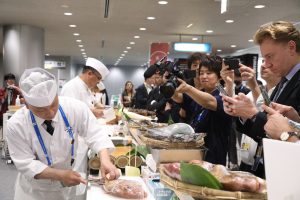
The ‘Setouchi (Inland Sea) Fish’ demonstration attracted lots of interest from the international media
Menus using lots of local ingredients were offered in collaboration with the ‘Citizens Council for the Hiroshima Summit’, a public-private organisation comprised of Hiroshima Prefecture, the City of Hiroshima and representatives from organisations in various fields such the region’s economy, transportation and healthcare. QR codes were placed on dining tables with links to explanations on the origin of the ingredients and the cooking process. The explanations not only served to convey the menus’ features, but also effectively showcased Japanese culinary culture and the efforts to tackle sustainable meetings and events through food, which was an important facet of our operational responsibilities.
Furthermore, a focus was placed on reducing food waste, which as many IAPCO members know is a long-standing challenge in hosting meetings and events. Congrès partnered with ‘SETOUCHI Compost’, based in Miyoshi City, Hiroshima Prefecture, to introduce a ‘Return to the Earth’ Food Loss Prevention Plan. Cooking waste and leftover food was mixed with the natural mud generated at water purification plants in Hiroshima Prefecture, transforming them into highly nutritious soil, which was then donated to local farmers and ranches. This initiative garnered significant interest from local media and resulted in a televised interview with Congrès employees after the Summit.
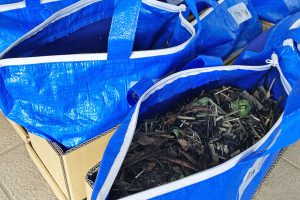
Cooking waste and leftover food were put into these protective bags containing compost in the IMC kitchen, to be donated later to local farmers and ranches
To ensure that the media from around the world had access to food 24/7, various items such as rice balls, bread, ‘bento’ boxed meals, instant noodles from local companies, beverages, snacks and instant ‘miso’ soup were provided in the working spaces.
Items that could not be completely distributed at the IMC were donated to Hiroshima Prefecture’s food banks, specifically the ‘Hiroshima “Kodomo-Shokudo” (organisations that provide meals and a place to visit for children) Support Centre’ and ‘FOOT and WORK Social Gastronomy Food Bank “Yuruthi.”’ Congrès was honored to receive letters of appreciation from these organisations.
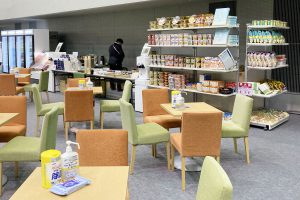
One of the catering corners in the IMC, with an array of foods and snacks for casual eating at any hour
Over 80 Exhibitions conveying Japan and Hiroshima’s traditions, cutting-edge technology and legacy for peace
The IMC also featured more than 80 exhibits by the Japanese government, local authorities, corporations and organisations that promoted Japan’s efforts toward achieving a peaceful society and creating a sustainable future, as well as showcasing Japanese traditional culture and cuisine to the world. Initiatives towards achieving carbon neutrality were also presented. Media representatives were also able to experience a VR tour of the interior of the Atomic Bomb Dome (not normally open to the public), tea ceremony and taste testing of Hiroshima Wagyu beef and oysters.

Open-air exhibition with over 30 recycled shipping containers that housed exhibits by corporations and organisations on efforts to achieve carbon neutrality, etc. (‘Sunken Garden’ venue)
The Citizens Council for the Hiroshima Summit also hosted an ‘Exhibition of Hiroshima’ within the IMC to communicate Hiroshima’s history, diverse attractions, technological advancements and traditional crafts to the international media. Included were artifacts from the Hiroshima Peace Memorial Museum that world leaders and their partners visited during the Summit, to convey the story of recovery after the bombing, emphasising the importance of preserving the legacy of peace.
Post-Summit inspection/observational tour of G7 Summit meeting venues for Hiroshima students and local citizens
Following the conclusion of the Summit, an ‘After-Summit Tour’ was organized for local elementary, junior and senior high school students and residents to explore selected facilities related to the Summit (hosted by the Ministry of Foreign Affairs (MOFA) and the Citizens Council for the Hiroshima Summit). Participants had the opportunity to visit the IMC and touch the round table and chairs used during the leaders’ meetings, explore the government promotional exhibitions, and learn about Hiroshima’s diverse attractions and the realities of the atomic bombing at the ‘Exhibition of Hiroshima’, enabling them to sense the Summit atmosphere. This program aimed to stimulate the local community, promote SDGs, and leave both tangible and intangible legacies, which are essential aspects of hosting international conferences, in tandem with the debates and negotiations.
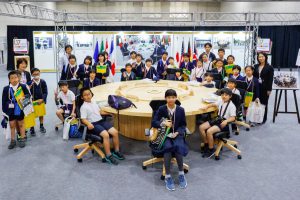
Elementary school children sitting at the actual table used at the G7 Summit.
Photo courtesy of MOFA Secretariat for the G7 Hiroshima Summit’s official Twitter account.
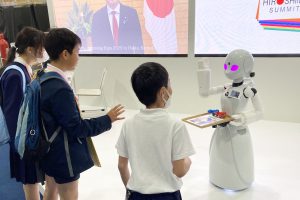
Observing the exhibition where Japan’s technology and culture were disseminated throughout the world
Other Sustainability Endeavours: Biodiesel fuelled shuttle buses and Staff accommodations
Transportation logistics was also a key area of responsibility for Congrès, to make certain that media representatives visiting from various countries, many no doubt for the first time, could move smoothly around Hiroshima, while striving to ensure environmentally friendly travel. One feature was our collaboration with Euglena Co., Ltd. to utilise their next-generation biodiesel fuel ‘SUSTEO’ in certain vehicles, such as shuttle buses only used late at night or rush hour, to encourage use of public transportation.
As for our IMC operations’ employees, in lieu of hotel accommodations (not available due to the massive number of people, tens of thousands per day, supporting the G7 Hiroshima Summit operations), we rented vacant apartments scheduled for demolition after the Summit, and purchased new bedding and other equipment: some employees stayed for over 1 month. Used items were not discarded, but donated to the Hiroshima Association of Certified Social Workers, to contribute to the community.
Congrès would like to take this opportunity to express our appreciation for the support and cooperation of all stakeholders, including our fellow (IAPCO) member JCS, in the efforts to support media professionals, and contribute to social responsibility and the development of future generations during the G7 Hiroshima Summit.
Photos provided by: Ministry of Foreign Affairs of Japan
